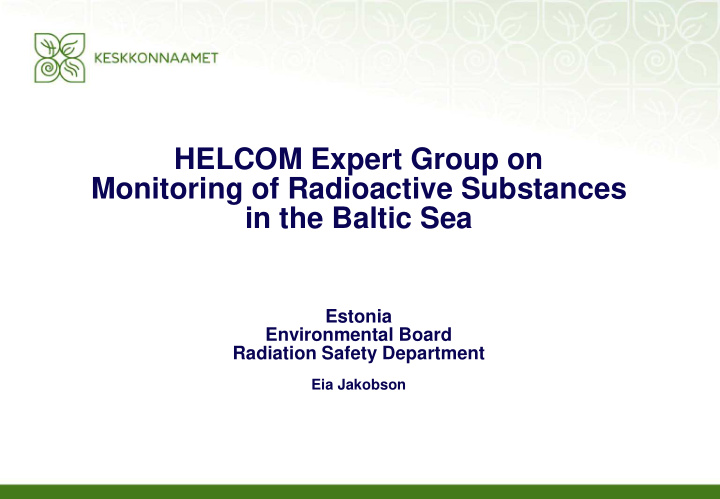



HELCOM Expert Group on Monitoring of Radioactive Substances in the Baltic Sea Estonia Environmental Board Radiation Safety Department Eia Jakobson
HELCOM MORS EG • The HELCOM-MORS EG (Monitoring of Radioactive Substances Expert Group) was established 1984 to monitor radioactive substances in the Baltic Sea • The overall objective of the HELCOM MORS EG is to implement the Helsinki Convention on matters related to monitoring and assessment of radioactive substances in the Baltic Sea
Main responsibilities Annual reporting to the State of Environment and Nature • Conservation Working Group (HELCOM STATE) in order to keep the Commission and the Contracting Parties informed on: o the environmental data and discharge data on radioactivity submitted to the HELCOM databases Assessment reports ( latest being Thematic assessment of longterm • changes in radioactivity in the Baltic Sea, 2007-2010) Annual updates of the Indicator Fact Sheets • o Core indicator report: Caesium-137 ( 137 Cs) in fish and surface seawater o Environmental fact sheets: 1) Liquid discharges of Cs-137, Sr-90 and Co-60 into the Baltic Sea from local nuclear installations 2) Total amounts of the artificial radionuclide caesium-137 in Baltic Sea sediments
Current activities of MORS EG Monitoring of radionuclides in the seawater, biota and sediments is continued and • carried out by Contracting Parties according to HELCOM Recommendation on Monitoring of Radioactive Substances Environmental and discharge data was reported to the HELCOM database by • Contracting Parties Activities related to the analytical quality assurance and ensuring the reliability of • data are continued: - in 2015 large volume sampling for HELCOM MORS seawater intercomparison was arranged by BSH, Germany - the laboratories of HELCOM Contracting Parties are involved in ohter intercomparisons organized by International Atomic Energy Agency in Monaco
Current activities of MORS EG • In 2016 the 6th HELCOM MORS EG Meeting took place in Uppsala in Sweden: - Information on current situation based on national data was presented by Representatives of Contracting Parties - MORS EG Members were informed about current status of environmental data and discharge data, the data was checked and validated - Guidelines on Monitoring of Radioactive Substances in The Baltic Sea relating to the Recommendation 26/3 were revised - Terms of Reference of HELCOM MORS EG were revised for the STATE AND CONSERVATION Group consideration
Current activities of MORS EG • The work on Indicator reports and assessments is continued 1. The core indicator report “Radioactive substances: Cs-137 in fish and surface seawater” based on data up to 2015 will be updated. It is expected to be ready at the latest by the end of 2016, when data from all Contracting Parties will be available in the HELCOM database. 2. The environmental fact sheets: - Liquid discharges of Cs-137, Sr-90 and Co-60 into the Baltic Sea from local nuclear installations - Total amounts of the artificial radionuclide caesium -137 in Baltic Sea sediments will be updated.
Current activities of MORS EG 3 . Work on a new thematic assessment of long-term changes in radioactivity in the Baltic Sea covering the period 2011-2015 is continued. The Meeting agreed to prepare updated drafts of all chapters for circulation for the Members of the MORS EG by the end of 2016 at the latest. It should be ready for endorsement by State and Conservation in spring 2017 and for approval for publication at the meeting of HELCOM HOD in June 2017.
Recommend
More recommend